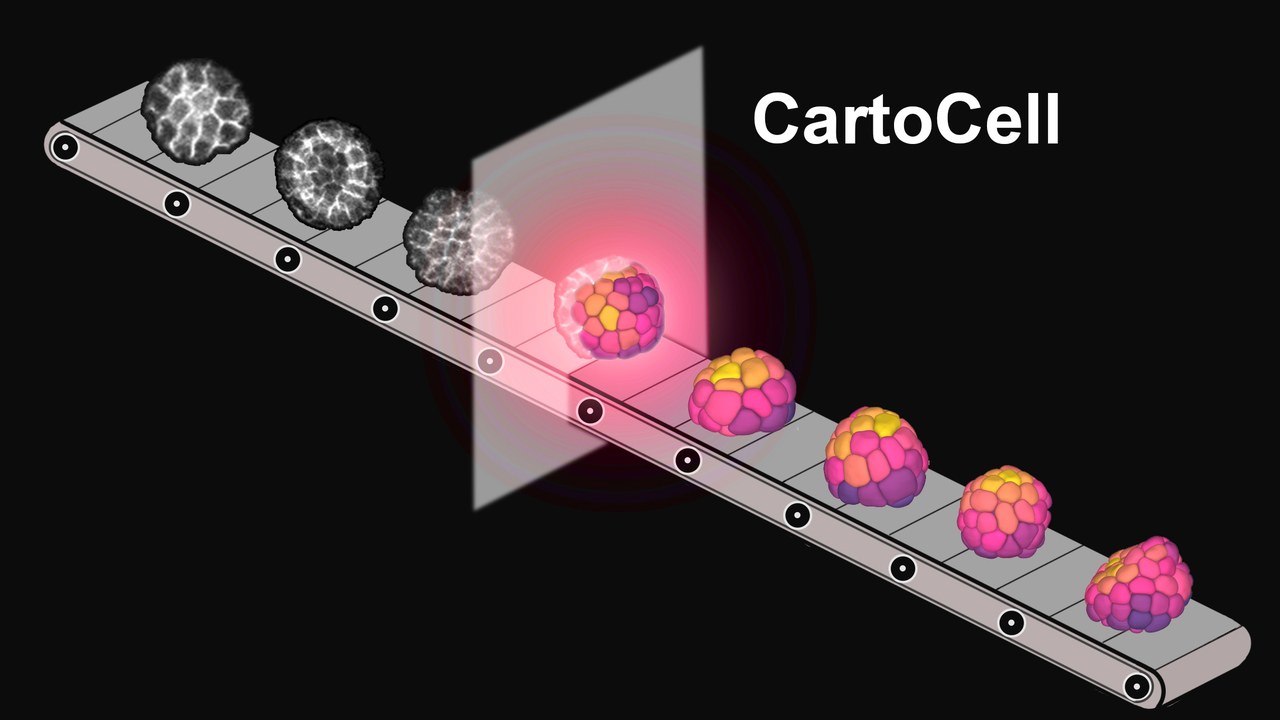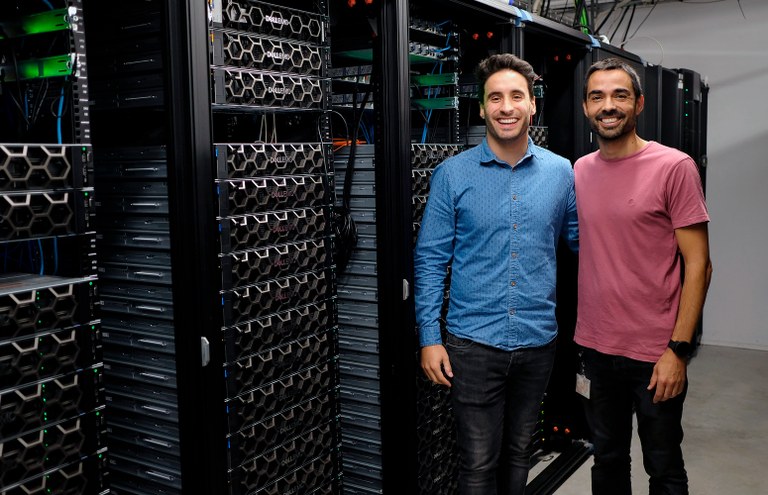An open-source tool capable of detecting hidden patterns in cellular tissues
CartoCell is a 3D image analysis tool that uses artificial intelligence to uncover hidden cellular morphology patterns in epithelial tissues. CartoCell was developed by research groups from the Institute of Biomedicine of Seville (IBiS), the University of the Basque Country/DIPC/Biofisika Institute and other prestigious centers as an open-source tool.

A recent collaboration between the Biomedicine Institute of Seville (University Hospital Virgen del Rocío/CSIC/University of Seville), the University of the Basque Country, the Biofisika Institute, the Donostia International Physics Center, and other prestigious national and international centers, has resulted in the publication in the journal Cell Reports Methods of CartoCell, a high-content 3D image analysis tool that reveals hidden cellular morphology patterns. This open-source software has great potential for application in both basic sciences, with which it has already been tested, as well as for clinical and medical development.
In Search of Hidden Patterns
Animals and plants, along with other structures of nature, display patterns that we can easily detect: the stripes of zebras, the polygons of giraffes, or the shells of turtles, for instance. All these patterns have in common that they are macroscopic. However, this same phenomenon occurs at the microscopic level, in tissues. "These patterns also appear during embryonic development," explains Luis M. Escudero, one of the authors and a researcher at the Institute of Biomedicine of Seville (IBiS) and Professor at the University of Seville. "For instance, there are genes that express in alternating stripe patterns and are fundamental for establishing insect segments." Many of these patterns are already well-known and extensively studied, yet there is much left to discover.
"In our work, we have found patterns that were still hidden... And that could only be unveiled using artificial intelligence tools for the analysis of microscopic tissue images. We see that, even in very simple structures, there are already asymmetries in cell morphology. This is how morphogenesis begins." Morphogenesis refers to the biological process that causes an organism to develop its shape and structure. It's one of the fundamental stages during embryonic development and concerns the organization and spatial distribution of differentiated cells to form specific structures and eventually complete organs.
CartoCell, a Tool for Mapping Epithelial Tissues
"CartoCell is a software tool that allows for the quick and automatic processing of a vast number of 3D images taken with the microscope for the reconstruction and analysis of epithelial tissues at the cellular level," continues Dr. Escudero. In other words, this digital tool is capable of processing an immense amount of information automatically, specializing in searching for patterns, shapes, distributions, and structures in tissues from images.
He further clarifies that CartoCell leverages the power of neural networks, specifically an artificial neural network designed to optimize the identification of three-dimensional cells in microscopy images. CartoCell's primary advantage is that it can identify and study the shape and spatial distribution of each cell in the epithelial tissue, allowing for the discovery of patterns associated with different types of tissues.
"Every cell in the tissue is reconstructed with high fidelity, thanks to which we can study both its shape and its spatial distribution. In this way, CartoCell allows us to discover patterns associated with different types of tissues and cells, as well as study their packing rules." For now, the software has been used for basic science studies, mapping cell morphology with images from various types of tissues. "In this way, we have been able to find hidden patterns in a simple and very visual manner," continues the researcher, "which is essential for studying the organization of epithelial tissues where cells have close contact."
But, besides the hidden patterns and the biological tissue research, CartoCell also shows great potential for clinical application. "In the biomedical field, the ability to analyze a large number of samples quickly and reliably, as CartoCell does, is ideal for assessing the reproducibility of organoid cultures [small tissues created to simulate a small organ] and making detailed comparisons between normal and pathological conditions. To give a simple example," the researcher continues, "testing the effect of drugs on animal or human tissues could benefit from our method. Our advanced image analysis could detect subtle cellular-level changes, which in the long run can be significant, of the effect of each drug against a specific disease."
Neural Networks and Open Source at its Core
The heart of CartoCell is an artificial neural network. The architecture of the network was designed based on other models previously developed by the research group in artificial vision for bioimaging from the Instituto Biofisika and the Donostia International Physics Center (DIPC) in the Basque Country, which participates in the project. "These models had already demonstrated great versatility and robustness for similar problems in various microscopy images (such as electron microscopy and confocal microscopy, among others)," explains Dr. Ignacio Arganda, leader of this group and Ikerbasque researcher also affiliated with the University of the Basque Country (UPV/EHU). "Specifically, the architecture and the output images it produces were adapted to optimize the identification of three-dimensional cells acquired through microscopy techniques."
"Like every artificial neural network," he continues, "ours requires what's known as a training set to learn the task we propose. In our case, this task is the identification (or ‘segmentation’) of epithelial cells in three-dimensional images." Normally, for a neural network to generalize and perform this task accurately, it needs a large and heterogeneous dataset. Building such a dataset involves a lot of manual work, as each cell in the 3D training images would need to be "painted."
"However," the expert clarifies, "CartoCell uses a very small initial training set of painted epitheliums. With that set, we train our neural network for the first time, trying to predict cell identities in many other epithelial images. As expected, the result is not ideal, as many cell identities are incomplete, leaving gaps between cells. To solve this, we use a Voronoi algorithm that fills the empty spaces between identified cells, ensuring they make contact."
"These transformed cell labels are what we call weak labels, and we use them as our new training set. Although these labels are not completely perfect, they realistically capture cell morphology (since epithelial cells share some organizational characteristics with Voronoi patterns). Moreover, being many and very heterogeneous, they help improve the network re-training process. This step is key in CartoCell, as it allows us to achieve excellent segmentation results without spending excessive time manually labeling a large training set," the researcher completes.
One of CartoCell's features is its versatility, according to Dr. Pedro Gómez-Gálvez, another author of the work, currently in the Department of Physiology, Development, and Neuroscience at the University of Cambridge (UK). Specifically, its neural network could be replaced by any state-of-the-art segmentation model (3D convolutional neural networks or any of its variants), as long as the concept of light labeling or "weak labels" previously described to improve the training set is used. "In fact, in our paper, we tested several modern network architectures, and with all of them, the results were very good after light labeling following the Voronoi algorithm," Gómez-Gálvez confirms.
Furthermore, CartoCell is an open-source tool, offering experts the opportunity to freely use, improve, or adapt it. "All of us involved in CartoCell's creation strongly believe in the idea of open science. Consequently, CartoCell has been implemented from day one as open source and has always been available to the community. In that sense, our intention has been to create an accessible tool, easy to install and use by non-experts, but also adaptable and expandable for those who want to develop new solutions based on it," he concludes.

In addition to the Biomedicine Institute of Seville and the University of the Basque Country, the Instituto Biofisika, the Donostia International Physics Centers, this work also involved researchers from the University of Seville, the Severo Ochoa Molecular Biology Center in Madrid, and the MRC Laboratory of Molecular Biology in Cambridge, UK, among other institutions.
Reference: CartoCell, a high-content pipeline for 3D image analysis, unveils cell morphology patterns in epithelia. Jesus A. Andres-San Roman, Carmen Gordillo-Vazquez, Daniel Franco-Barranco, Laura Morato, Cecilia H. Fernández-Espartero, Gabriel Baonza, Antonio Tagua, Pablo Vicente-Munuera, Ana M. Palacios, María P. Gavilán, Fernando Martín-Belmonte, Valentina Annese, Pedro Gómez-Gálvez, Ignacio Arganda-Carreras, Luis M. Escudero. Cell Reports Methods, 2023.
